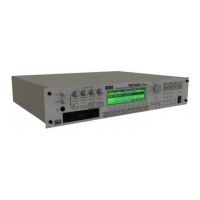54
Adjusting the BPM of multisamples or samples cre-
ated in Sampling mode
If a timbre program uses multisamples or samples that
you created in Sampling mode (or loaded in Disk
mode) to a specific BPM value, you can use the
“Detune BPM Adj.” utility with a specified BPM
value. This changes the BPM by changing the playback
pitch. (
☞PG p.38)
Note timing and scale settings
3.2: Ed–Param2
Other page
Delay [ms]
Specifies the timing at which the program of each tim-
bre will sound.
Select the preload combination INT–A127: One Fin-
gerTVShow, and play a single note on a connected
MIDI instrument. Timbres will sound consecutively,
according to their Delay setting. If you select KeyOff
for this parameter, the timbre will sound when the note
is released.
Use Prog’s Scale, Combi’s Scale
Specifies the scale for each timbre. If you check “Use
Prog’s Scale,” the scale specified by the program will
be used. Timbres for which this is not checked will use
the “Combi’s Scale” setting.
Layer and split settings
3.3: Ed–Key Zone
Indicates settings such as layer, split, and keyboard
crossfade.
Key page
Specifies the range of notes that will sound each tim-
bre.
Each area that sounds a timbre is referred to as a Key
Zone. By setting key zones, you can create a combina-
tion in which different programs sound in different
areas of the keyboard.
By combining key zones specified for each timbre, you
can create layered or split combinations.
The upper and lower limits for the key zone of each
timbre are set by the “Top Key” and “Bottom Key”
respectively.
For example in the following diagram, timbres 1–3 are
set to create a layered and split combination. This is
specified by the key zone settings.
Timbres 2 and 3 create a layer. Timbre 1 and timbres 2/
3 are split between the B3 and C4 note numbers.
As an example here, we will explain how to create a
combination like the one shown above.
1 In 1.1: Play or 2.1: Ed-Prog/Mix, select the pro-
grams that timbres 1–3 will use.
Select a piano program for timbre 1.
Select a brass program for timbre 2.
Select a strings program for timbre 3.
2 In the MIDI page of 3.1: Ed-Param1, set “Status” to
INT for all the timbres that you wish to use, and
set “MIDI Channel” to either Gch or to match the
global MIDI channel (a “G” will be displayed
after the channel number).
3 In the Key page of 3.3: Edit-Key Zone, set “Top
Key” and “Bottom Key.”
Set timbre 1 to a “Top Key” of G9 and a “Bottom
Key” of C4.
Set timbres 2 and 3 to a “Top Key” of B3 and a “Bot-
tom Key” of C–1.
You can also enter these values by holding down the
[ENTER] key and playing a note on a connected
MIDI instrument.
Slope page
Here you can specify the range of keys over which the
original volume will be reached, starting at the top key
and bottom key.
In the case of the above example, you could set the key
zones so that a portion of timbres 1 and 2 overlaps (i.e.,
is layered) with timbre 3, and set “Top Slope” and
“Bottom Slope” so that the sound changes gradually,
instead of changing suddenly between B3 and C4.
Velocity switch settings
3.4: Ed–Vel Zone
Here you can make settings for velocity switching and
velocity crossfading.
Vel (Velocity) page
For each timbre, you can specify a range of velocities
for which it will sound. The range of velocities for
which a timbre will sound is called the Velocity Zone.
By setting a velocity zone, you can set up a timbre
which will be sounded only by notes played at a cer-
tain strength, and not by stronger or weaker notes.
By combining timbres that have differing velocity zone
settings, you can create velocity switched combina-
tions.
The upper and lower limits of the velocity zone of each
timbre are determined by the “Top Velocity” and “Bot-
tom Velocity” respectively. The following diagram
PianoTimbre 1
Brass
Timbre 2
Strings
Timbre 3
C–1 C4 G9B3

